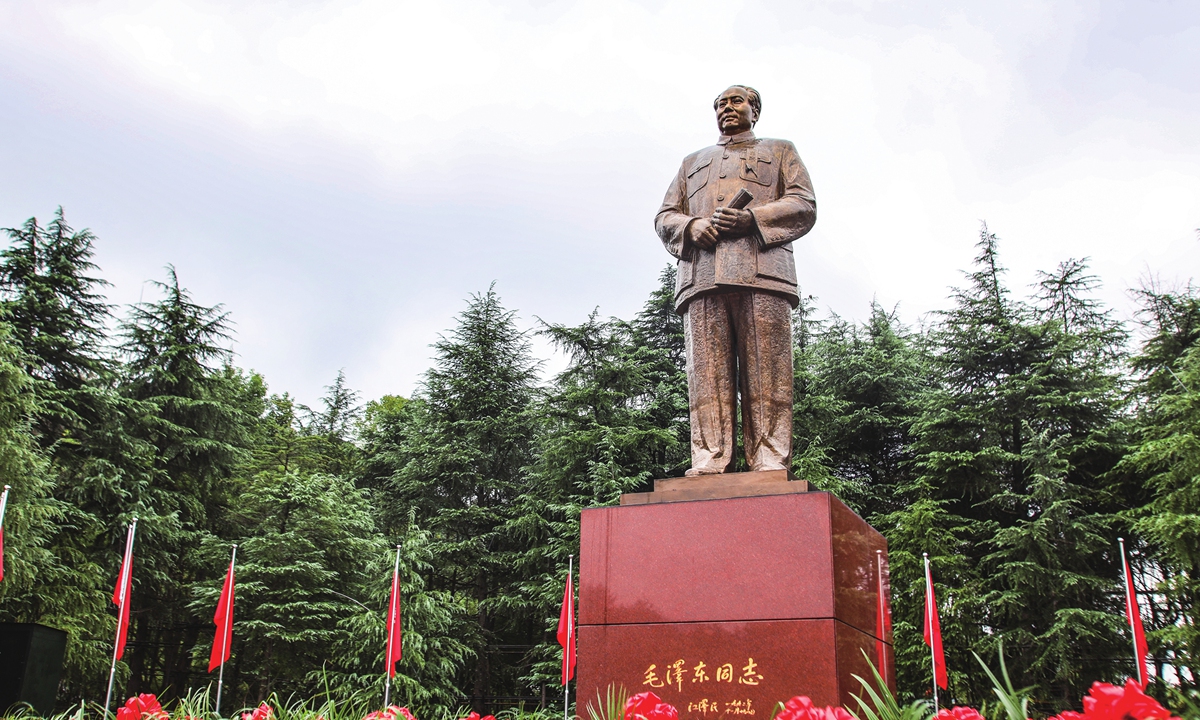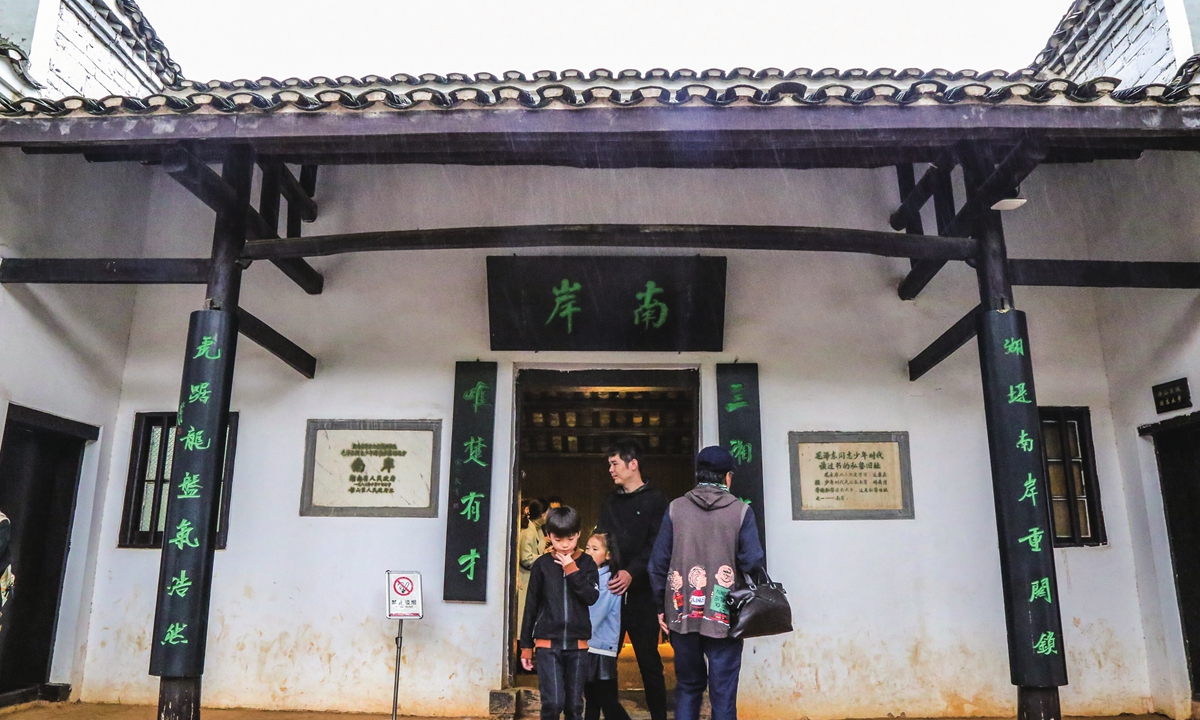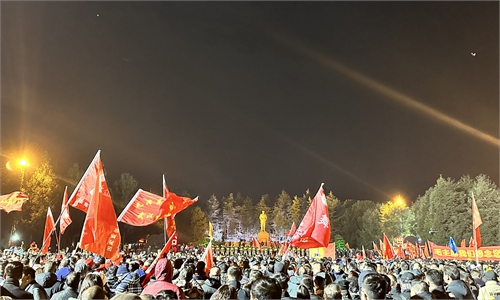ARTS / CULTURE & LEISURE
In Shaoshan, Chairman Mao revered by visitors from across the nation
Hometown of late leader

The bronze statue of Mao at the Mao Zedong Square in Shaoshan, Central China's Hunan Province Photo: VCG

Nan'an Old-style Private School, the place where late Chairman Mao studied Photo: VCG
It has been a couple weeks since December 26, 2023, the day that marked the 130th anniversary of the birth of late Chinese leader Mao Zedong. People from all walks of life flocked to the Mao Zedong Square in Shaoshan, Central China's Hunan Province, in what looked like an endless stream to lay flower baskets in front of the bronze statue of Chairman Mao to remember him.
I was among them, enjoying my first-time visit to Shaoshan in my quest to find answers about the birthplace of China's late Chairman Mao: what did the area look like? How was the Chairman's early life there?
Mao's early life
Tourist attractions in Shaoshan depict for visitors Mao's former home and provide historical information about him. These include his former residence, the memorial hall, the memorial park, the bronze statue square, the cultural relics museum, the local library and the main Mao Zedong Memorial Hall.
The square lies beside Mao's birth place, the Shaoshan village, about 104 kilometers from the provincial capital of Changsha. Located on the mid-eastern Hunan and the mid-north of Xiangtan, Shaoshan borders the Ningxiang county to the north, Xiangxiang city to the west and southwest, and the Xiangtan county to the east and southeast.
Because of its unique natural environment and history, the square has become a famous scenic spot and is regarded as a shrine to commemorate the Chinese revolution.
Covering 102,800 square meters, the Mao Zedong Square features a 10.1-meter-tall bronze statue of the great man, commonly known as Chairman Mao. The present square is an expanded and renovated version of the former Square of Comrade Mao Zedong's Bronze Statue and it receives millions of visitors from home and abroad every year.
Not far away is Chairman Mao's former residence, which covers an area of nearly 473 square meters and is made of mud, brick and blue tiles.
This was Mao's birthplace and childhood home. The building is now a national 5A scenic spot, a red tourism site and also a popular tourist destination. Mao lived there until 1910, when he left his hometown for education.
With 13 rooms, the house is decorated with photos of the Maos, daily necessities and farm tools such as buckets, carrying poles and hoes. Sitting south and facing the north, the abode is a typical southern-China farmer's house, placed against a bucolic backdrop of green hills and featuring a pond in its front yard.
The room's furnishings have been kept as they were when Mao lived there, and most of the utensils on display are original pieces. Mao's family shared the middle hall with their neighbors, while the whole complex forms a concave shape, which was a typical house design in Hunan Province at that time.
Ways to honor Mao
"More minds grow stronger for the martyrs' sacrifice, daring to move the sun and the moon to new skies. Happy I see now wave upon wave of corn and rice, here and there heroes come home at dusk as smokes rise."
Thirty-two years after Mao Zedong left his homeland Shaoshan in 1927, he wrote this seven-character verse in 1959 to express his feelings about the grit of Chinese revolution martyrs and about the changes that took place in his hometown, an area that was the backdrop to his early revolutionary years.
Visiting the Mao Zedong Memorial Hall is not just a major look back on Mao's life and the sacrifices that his family made for the revolution, but also a deep understanding of what he wanted to express in the verse and what changes he had experienced during his revolutionary life.
Nowadays, we don't have to go through the same kind of sacrifices and pain that characterized those dark days and our young people are lucky enough to have inherited the fruits of such past endeavors. Indeed it is thanks to those who have sacrificed themselves for the cause that the spirit and wisdom of Mao Zedong are still alive and can be treasured by young generations.
One proof of this is the fact that more and more representatives of generation Z are turning into streaming sites like Bilibili and Douyin, and social media platforms like Weibo, to share Mao's wisdom and military genius.
After visiting the Mao Zedong Memorial Hall, many people run into the cultural souvenir shop, hoping to get a notebook with Mao's portrait on the cover and seals made of Mao's many mottoes including "Serve the People" and "Use your own two hands to gather sufficient food and clothing." This is one way for visitors to remind themselves of Chairman Mao's ideas through keepsakes and quotes.
Another way is to walk into any of Mao's Family Restaurants, where portraits of Mao watch over diners savoring one of his favorite foods, the Red-Braised Pork, a typical dish from Hunan that Mao Zedong remained partial to, even while residing in Beijing.
Shaoshan offers a variety of locations and resources to remember the past and celebrate the beloved late leader and maybe one day is far from enough to experience them all, but a trip to Shaoshan is certainly a first step toward better understanding the value and history of the Chinese revolution and of Chairman Mao's wisdom.


